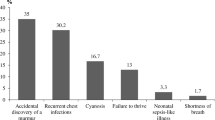Abstract
Background
Congenital heart defects (CHD) are the most common single organ malformations in humans. A comprehensive study was initiated within the Competence Network for Congenital Heart Defects to assess population-based nationwide prevalence data for Germany.
Methods
Study register of demographic and medical data of live births with CHD born between July 2006 and June 2007.
Results
Seven thousand two hundred forty-five live births and infants with CHD were registered in Germany by 260 participating institutions (prevalence 107.6 per 10,000 live births). The most common lesions were ventricular septal defect, atrial septal defect and valvular pulmonary stenosis with 52.7, 18.3 and 6.6 per 10,000 live births, respectively. A single ventricle, tetralogy of Fallot and the complete transposition of the great arteries were the most common severe cardiac lesions (3.0, 2.7 and 2.3 per 10,000 live births). Parents reported that prenatal echocardiography had been performed in 53.8% of severe CHD cases with a cardiac defect detected in 77.5% of them.
Conclusion
The reported prevalences of severe CHD are within the range of regional and European comparative data. The prenatal detection rate of severe cardiovascular malformations is comparable to contemporary European registries. Postnatal diagnosis of the CHD has been made early in life.


Similar content being viewed by others
References
Mitchell SC, Korones SB, Berendes HW (1971) Congenital heart disease in 56,109 births. Incidence and natural history. Circulation 43:323–332
Lechat MF, Dolk H (1993) Registries of congenital anomalies: EUROCAT. Environ Health Perspect 101(Suppl 2):153–157
Dastgiri S, Stone DH, Le-Ha C, Gilmour WH (2002) Prevalence and secular trend of congenital anomalies in Glasgow, UK. Arch Dis Child 86:257–263
Schoetzau A, van Santen F, Sauer U, Irl C (1997) Kardiovaskuläre Fehlbildungen in Bayern 1984-1991. Z Kardiol 86:496–504
Queißer-Luft A, Spranger J (2006) Fehlbildungen bei Neugeborenen. Dtsch Arztebl 103:2464–2471
Rösch C, Steinbicker V (2002) Das Fehlbildungsmonitoring Sachsen-Anhalt: Vorstellung des ersten Jahresberichtes zu Fehlbildungen bei Neugeborenen im gesamten Bundesland. Ärzteblatt Sachsen-Anhalt 13:18–24
Lange PE (2006) Vernetzung hilft, Forschungs- und Versorgungsdefizite zu beseitigen. MedWelt 57:122
Bauer U, Niggemeyer E, Lange PE (2006) The competence network for congenital heart defects. Networking instead of isolated efforts for optimized research and care. Med Klin 101:753–758
Lindinger A, Schwedler G, Hense HW (2010) Prevalence of congenital heart defects in newborns in Germany: results of the first registration year of the PAN study (July 2006 to June 2007). Klin Padiatr 222:321–330
Reng C-M, Debold P, Specker C, Pommerening K (2006) Generische Lösungen zum Datenschutz für die Forschungsnetze in der Medizin. Medizinische Wissenschaftliche Verlagsgesellschaft
Helbing K, Demiroglu SY, Rakebrandt F, Pommerening K, Rienhoff O, Sax U (2010) A data protection scheme for medical research networks. Review after five years of operation. Method Inf Med 49: Epub ahead of print
Committee of the Association for European Paediatric Cardiology (2002) The European Paediatric Cardiac Code: the first revision. Cardiol Young 12:1–211
EUROCATWebsiteDatabase. http://www.eurocat-network.eu/ACCESSPREVALENCEDATA/PrevalenceTables. Data uploaded 14 April 2010, accessed 30 June 2010
Dilber D, Malcic I (2010) Spectrum of congenital heart defects in Croatia. Eur J Pediatr 169:543–550
Moons P, Sluysmans T, De Wolf D, Massin M, Suys B, Benatar A, Gewillig M (2009) Congenital heart disease in 111 225 births in Belgium: birth prevalence, treatment and survival in the 21st century. Acta Paediatr 98:472–477
Steinbicker V, Rösch C (1998) Monitoringsystem angeborener Herzfehler. PerinatalMedizin 10:45–48
Pötzsch S, Hoyer-Schuschke J, Köhn A, Vogt C, Götz D, Loderstedt M (2009) Jahresbericht des Bundeslandes Sachsen-Anhalt zur Häufigkeit von congenitalen Fehlbildungen und Anomalien sowie genetisch bedingten Erkrankungen 2008. Fehlbildungsmonitoring Sachsen-Anhalt an der Medizinischen Fakultät der Otto-von-Guericke Universität Magdeburg
Hoffman JI, Kaplan S (2002) The incidence of congenital heart disease. J Am Coll Cardiol 39:1890–1900
Oyen N, Poulsen G, Boyd HA, Wohlfahrt J, Jensen PK, Melbye M (2009) National time trends in congenital heart defects, Denmark, 1977–2005. Am Heart J 157:467–473
Khoshnood B, De Vigan C, Vodovar V, Goujard J, Lhomme A, Bonnet D, Goffinet F (2005) Trends in prenatal diagnosis, pregnancy termination, and perinatal mortality of newborns with congenital heart disease in France, 1983–2000: a population-based evaluation. Pediatrics 115:95–101
Garne E, Stoll C, Clementi M (2001) Evaluation of prenatal diagnosis of congenital heart diseases by ultrasound: experience from 20 European registries. Ultrasound Obstet Gynecol 17:386–391
Grandjean H, Larroque D, Levi S (1999) The performance of routine ultrasonographic screening of pregnancies in the Eurofetus Study. Am J Obstet Gynecol 181:446–454
Germanakis I, Sifakis S (2006) The impact of fetal echocardiography on the prevalence of liveborn congenital heart disease. Pediatr Cardiol 27:465–472
Acknowledgments
We would like to express our thanks to all cooperating paediatric cardiology institutions. They are cited in the “Supporting Information” [9]. We would like to thank J. Frei, A.-M. Körten, S. Pöpke, M. Frey, H. Brames and A. Meyer-Rapp for their support in data collection and management. The project was supported by the Competence Network for Congenital Heart Defects, under the sponsorship of the Federal Ministry for Education and Research (FKZ 01GI0601).
Conflict of interest
The authors declare that they have no conflict of interest.
Author information
Authors and Affiliations
Corresponding author
Rights and permissions
About this article
Cite this article
Schwedler, G., Lindinger, A., Lange, P.E. et al. Frequency and spectrum of congenital heart defects among live births in Germany. Clin Res Cardiol 100, 1111–1117 (2011). https://doi.org/10.1007/s00392-011-0355-7
Received:
Accepted:
Published:
Issue Date:
DOI: https://doi.org/10.1007/s00392-011-0355-7




